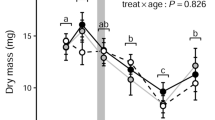Abstract.
This study examined how developing fish larvae regulate their Ca2+ balance for acclimation to low ambient Ca2+. Calcium balance in newly hatched larvae was examined individually. Developing larvae not only increased Ca2+ influx but also decreased Ca2+ efflux when they were acclimated to low-Ca2+ environments. After acclimation for 8 days, the influx and efflux of the low-Ca2+ (0.02 mM) group were about 106% and 43%, respectively, compared to those of the high-Ca2+ (1.0 mM) group. Sensitivity and response to low-Ca2+ environments are age-dependent. Upon acute exposure to low Ca2+, newly hatched (H0) larvae increased both Ca2+ influx (from 24% to 67% of high-Ca2+) and net uptake (from 5% to 69%) within 64 h, while 3-day-posthatching (H3) larvae managed to reach the levels of the control within 38 h. Declining Ca2+ efflux in H3 larvae occurred 14 h after exposure, much faster than those in H0 larvae (38 h). It is suggested that modulation of Ca2+-balance mechanisms in developing larvae is dependent upon the levels of Ca2+ in the larval body.
Similar content being viewed by others
Author information
Authors and Affiliations
Additional information
Electronic Publication
Rights and permissions
About this article
Cite this article
Chou, .MY., Yang, .CH., Lu, .FI. et al. Modulation of calcium balance in tilapia larvae (Oreochromis mossambicus) acclimated to low-calcium environments. J Comp Physiol B 172, 109–114 (2002). https://doi.org/10.1007/s00360-001-0231-2
Accepted:
Issue Date:
DOI: https://doi.org/10.1007/s00360-001-0231-2




